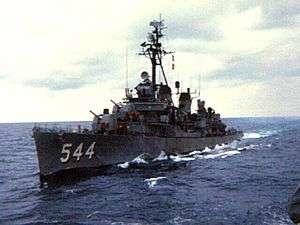USS Boyd (DD-544)
 | |
| History | |
|---|---|
| Namesake: | Joseph Boyd |
| Builder: | Bethlehem Shipbuilding Corporation, San Pedro, California |
| Laid down: | 2 April 1942 |
| Launched: | 29 October 1942 |
| Commissioned: | 8 May 1943 |
| Decommissioned: | 1 October 1969 |
| Struck: | 1 October 1969 |
| Fate: | Transferred to Turkey, 1 October 1969 |
| Name: | Iskenderun (D-343) |
| Acquired: | 1 October 1969 |
| Struck: | 1981 |
| Fate: | Scrapped |
| General characteristics | |
| Class and type: | Fletcher-class destroyer |
| Displacement: | 2,050 tons |
| Length: | 376 ft 6 in (114.7 m) |
| Beam: | 39 ft 8 in (12.1 m) |
| Draft: | 17 ft 9 in (5.4 m) |
| Propulsion: | 60,000 shp (45 MW); 2 propellers |
| Speed: | 35 knots (65 km/h) |
| Range: | 6500 nmi. (12,000 km) @ 15 kt |
| Complement: | 329 |
| Armament: |
|
USS Boyd (DD-544) was a Fletcher-class destroyer of the United States Navy, named for Joseph Boyd, who took part in Stephen Decatur's expedition into Tripoli harbor during the First Barbary War.
Boyd was launched 29 October 1942 by Bethlehem Steel Co., San Pedro, California, sponsored by Mrs. C. W. Styer, wife of Captain Styer, and commissioned 8 May 1943, Lieutenant Commander Ulysses S. G. Sharp, Jr. in command.
History
As a unit of the Pacific Fleet, Boyd departed for Pearl Harbor 14 July 1943. After additional training she took part in the occupation of Baker Island (1 September 1943) and then joined the Fast Carrier Task Force as a screening vessel for the Wake Island raid (5–6 October) and the Gilbert Islands landings (19 November–8 December).
On 26 November 1943, The USS Boyd was credited with sinking the IJN fleet submarine I-39, a Type B1/I-15 class (having a greater displacement than the Boyd itself, and carrying a scout seaplane) in the Gilberts area.[1]
During the bombardment of Nauru Island (8 December 1943) Boyd was damaged by a Japanese shore battery while on a rescue mission. Total casualties were one officer and 11 men killed, 8 wounded.[2] As a result she had to return to Espiritu Santo, New Hebrides, for repairs.
Following repairs Boyd arrived at Pearl Harbor 23 March 1944. She joined Task Force 58 (TF 58) for
- the Hollandia landings (21–24 April);
- Truk-Satawan-Ponape raid (29 April–1 May);
- Saipan landings (11–24 June);
- 1st Bonins raid (15–16 June);
- Battle of the Philippine Sea (19–20 June);
- 2d Bonins raid (24 June);
- 3d Bonins raid (3–4 July);
- invasion of Guam (12 July–15 August);
- Palau-Yap-Ulithi, raid (25–27 July);
- 4th Bonins raid (4–5 August);
- occupation of the southern Palaus (9–24 September),
- and Morotai landings (15 September).
She then joined TF 38 for the strikes against Okinawa (10 October), northern Luzon and Formosa (11–14 October), and Luzon (15 October), which preceded the Leyte landings. After taking part in the Battle for Leyte Gulf (24–25 October) she screened the carriers launching strikes against Luzon (5–6, 13–14, and 19–25 November).
Between 31 December 1944 and 22 January 1945 Boyd served as an escort vessel. She then took part in the bombardment of Iwo Jima and in the occupation of the island (19 February–1 March). She arrived off Okinawa 95 March and remained there on screening duty until 30 June. She then rejoined the 3rd Fleet for strikes against the Japanese home islands (10 July–7 August). One of the first vessels to return to the United States after the Japanese surrender, Boyd departed Okinawa 7 September and underwent overhaul at Mare Island Navy Yard (25 September–28 November). She then moved to San Diego, arriving 14 January 1948 and was placed out of commission in reserve 15 January 1947.
Recommissioned 24 November 1950, the destroyer reported to the Pacific Fleet. Following training off the west coast, Boyd departed for Korea 28 May 1951. She remained there, serving with TF 77 and on the Formosa Strait Patrol, until returning to San Diego 21 December 1951. Boyd departed San Diego 12 July 1952 for her second Korean tour. She served on the Wonsan blockade and took part in the amphibious demonstration off Kojo (6–15 October). She departed Korean waters in late January and arrived at San Diego 16 February 1953. After the end of the Korean fighting Boyd continued operations along the west coast and made three Far Eastern tours.
Boyd received 11 battle stars for World War II and five for her Korean War service.
TCG Iskenderun (D-343)
On 1 October 1969, Boyd was decommissioned, stricken from the Naval Vessel Register, and transferred to Turkey. She served in the Turkish Navy as TCG Iskenderun (D-343). In 1981, she was stricken and scrapped.
References
- This article incorporates text from the public domain Dictionary of American Naval Fighting Ships. The entry can be found here.